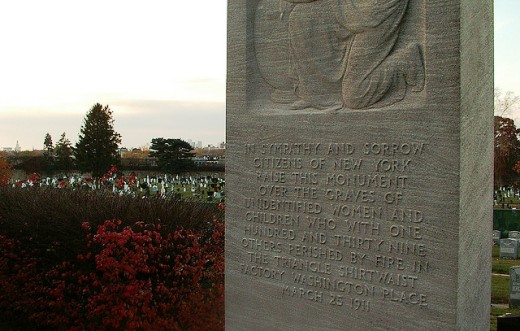
While walking through the Evergreen Cemetery recently, located in Ridgewood Brooklyn, I came across a section dedicated to eight unidentified young women who died in the Triangle Shirtwaist fire on March 25, 1911. This particular cemetery is extraordinary for its history. Among this extraordinary history is this beautiful sculpture dedicated to the 146 women who died on that fateful day. The monument depicts a kneeling woman in mourning for the victims, mostly of Jewish and Italian heritage.
Tomorrow, March 25, 2011, will mark the 100th anniversary of the Triangle Shirtwaist Fire. As I walked the neighborhood with a labor historian recently, it was chilling as he pointed to the eight and ninth floors of the former Asch Building (now the Brown building on Greene St. and Washington Place) and explained why these young immigrant women jumped to their death.
The tragedy of that day has brought about some laws to protect workers who toil to earn a living, raise families and all that that involves. Yet we know all to well that whatever safeguards were put in place after that tragic day are still inadequate. Witness the (preventable) mine explosion at the Massey mines last year that killed 29 coal miners.
How far we have come as a nation protecting our people is linked to the economic system that dictates how effective or how deficient of real safety mechanisms are put in place.
Stories surface today about the new immigrants who work the sweatshops. Unfortunately, they go pretty much unnoticed by the nation’s massive media. The attack on immigrants by the far right and the misguided continues to place hurdles in the effort to organize these workers.
And now we have Rep. Peter King from Long Island, N.Y., targeting yet another immigrant community – Muslims — with his bogus Homeland Security Committee hearings.
As the capitalist system continues to unravel, more and more pressure will be brought to bear on working families. That is why the tragedy 100 years ago must be kept alive as a reminder of what we must continue to fight for: humane and safe working conditions for all who work for a living.
Isaac Harris and Max Blanck, the owners of Triangle Shirtwaist, were put on trial and found not guilty, even though the locking of the doors of the factory led to the needless deaths of 146 women. Three years after the fire, on March 11, 1914, 23 individual civil suits against the owner of the Asch Building were settled. The average recovery was $75 per life lost.
There are many resources available about the Triangle Shirtwaist fire, the trial and the historical times in which it happened. The Department of Labor has a mobile-friendly website dedicated to the 100 year anniversary, which includes a tour of the relevant locations.
Photo: Part of the memorial for the Triangle Shirtwaist Factory fire in The Evergreens Cemetery in Brooklyn, N.Y. (semarr/CC)

MOST POPULAR TODAY

High Court essentially bans demonstrations, freedom of assembly in Deep South

U.S. imperialism’s ‘ironclad’ support for Israel increases fascist danger at home

UN warns that Israel is still blocking humanitarian aid to Gaza


Resource wars rage in eastern Congo, but U.S. capitalism only sees investment opportunity






Comments